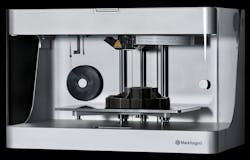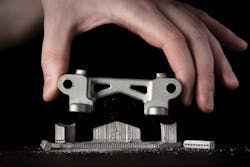Worried about your job or the health of the U.S. economy? You don’t have to be an economist to see that if a country exports less than imports, it could have a negative effect on the economy. As the Gross Domestic Product decreases, so does the number of jobs. Interestingly, the U.S. has been operating at a deficit for years. According to Census.gov, since 1976 we’ve been importing more than exporting.
The same site published: “For goods, the deficit was $810.0 billion in 2017, up from $752.5 billion in 2016. For services, the surplus was $244.0 billion in 2017, down from $247.7 billion in 2016.”
So what can we do to help turn the tables? 3D printing.
A 3D-Printed economy
In a report titled “3D printing: a threat to global trade,” ing predicts that printing good could cut trade between countries by 40%: “For now it has very little effect on cross-border trade. This will change once high speed 3D printing makes mass production with 3D printers economically viable. The first technical steps have already been taken…3D printers use far less labour, reducing the need to import intermediate and final goods from low wage countries.”
Admitting that it is tricky to define the exact potential of 3D printing, ing said some experts expect a share of 50% in manufacturing over the next two decades. Depending on growth and investment the report suggested that 50% of manufactured goods will be printed by 2060 with current investment growth. This figure could possibly be achieved as early as 2040 if investments double every five years.
In addition, 3D printing is estimated to wipe out almost one-quarter of world trade by 2060 under scenario I (or two-fifths by 2040 under scenario II). This would largely affect the automotive industry. This might change the way car manufacturers and aftermarket conduct business. Not only are you eliminating logistics and import tariffs, 3D printing parts will affect the intellectual property. If you thought intellectual property was difficult now with 3D printing, wait until every local parts shop is able to access this technology.
The new Markforge carbon fiber printer is able to produce load-bearing parts that require high strength. In some examples, it is possible to print parts faster and cheaper than machining metal.
Intellectual property is one of the largest U.S. service exports. This will affect industrial machinery, and consumer products are the other industries we can expect to suppress cross-border trade. These industries are the top investors in 3D printing. A little over 10 years ago, some were wondering if 3D printing was a fad. Today, investors might be able to predict what companies will increase or decrease revenue based on its investment in 3D printing.
By the Numbers
IP-intensive industries continue to be an important and integral part of the U.S. economy. A report from the United States Patent and Trademark Office (USPTO) identifies 81 industries (from among 313 total) as IP-intensive. These industries directly accounted for 27.9 million jobs in 2014, up 0.8 million from 2010.
The report noted that trademark-intensive industries are the largest in number and contribute the most employment, with 23.7 million jobs in 2014 alone (up from 22.6 million in 2010). Copyright-intensive industries supplied 5.6 million jobs (compared to 5.1 million in 2010) followed by patent-intensive industries with 3.9 million jobs (3.8 million in 2010).
- Revenue specific to the licensing of IP rights totaled $115.2 billion in 2012, with 28 industries deriving revenues from licensing.
- Total merchandise exports of IP-intensive industries increased to $842 billion in 2014 from $775 billion in 2010.
So if the U.S. invests heavier in 3D printing, it would reduce its imports and theoretically increase our economy. However, this technology is also a double-edged sword. Since IP, aerospace, gas, and automotive are large contributors to the U.S.’ exports, we might actually see a reduction in the exports of these markets.
Once a part is out in the field, there isn’t much keeping someone from taking some measurements and pictures. 3D printing might make pirating parts easier. Part pirates would still have the ability to take measurements and pictures in the field, but they could also find or hack an online database that would streamline the IP stealing industry. As more companies use online services and storage, once a blueprint is hacked, or accidentally emailed to the wrong person, there is no taking it back. Even if a company wanted to take legal action, with things like the dark web, it will be increasingly difficult to get the design back under the control of the IP’s owner.
The new Desktop Metal metal 3D printer uses powder metallurgy to print quickly and sinter parts in one step. In one example, an impeller was printed using a laser-based printer and the new Desktop Metal. In the time it took the laser based printer to produce 12 parts, Desktop Metal made more than 500.
Additionally, this will make things harder for emerging markets, companies, or countries, but again the focus will have to be where the money is: design. From inside3dprinting.com: “Global trade could become a thing of the past if 3D printing reaches a tipping point,” said Maxime Alimi, head of investment strategy for AXA Investment Managers in France. “The digital economy jeopardizes the development model of emerging markets entirely. If the export model is no longer available, it will become a lot more difficult for a market to emerge in the next decade—an issue that would greatly affect still-emerging countries in Africa.”
Not all Bad News
If proper investments are made in 3D printing and international agreements, it is possible to mitigate the bad and magnify the good. By focusing on IP, design, and cybersecurity, companies that find a way to make it easier and more cost effective to gain access to prints or parts legally will thrive. This will help develop easier-to-use online tools and 3D printers, as well as accelerate new designs. If a part is hacked, a company would be smart to upgrade the design. While some equipment might remain in operation for many years, it is impressive to see how new features and upgrades make old parts useless.
To minimize cost and maximize benefits, the U.S. must invest properly into technology. While 3D printing is new, the economy game is the same. The government already knows the importance of IP, and like many other industries, the U.S. needs to be on the leading edge with technology and grab the IP surrounding it. You can debate on the ethics or philosophies, but this is the main driver. And this new driver is obviously mitigating the technology to be user-friendly so it is easier to buy than steal. However, this is easier said than done, as the music industry—one of the first industries exposed to pirating—found out more than 18 years ago.
Most companies will only stock parts for so long, and pulling the tooling out for a short run can be difficult to justify the cost. 3D printing doesn’t require any tooling and specializes in low-volume production.
Porsche is one company starting to adopt 3D printing. To help its aftermarket, the automaker is focusing on its classic and rare parts that are difficult to get a hold of. Porsche identified 52,000 parts that could breathe life into some of its classic models if there was a way to reproduce parts in a cost-effective, low-volume manufacturing process. 3D printing these difficult-to-get parts is great for collectors, and as the technology expands, more common parts may be produced this way that will change the aftermarket and accessory automotive business.
To keep up with automation and customization, parts companies that offer online ordering and estimates for specific and custom parts will excel. Many of the prototyping and low-volume manufacturers already have this software, and some have said you couldn’t compete in this type of manufacturing without it.
For now it looks like we have time until 3D printing gains a large share in the shipping and logistics. However, companies that find a solution to these issues and develop a platform while the technology grows will stay ahead of the 3D-printed ball.





